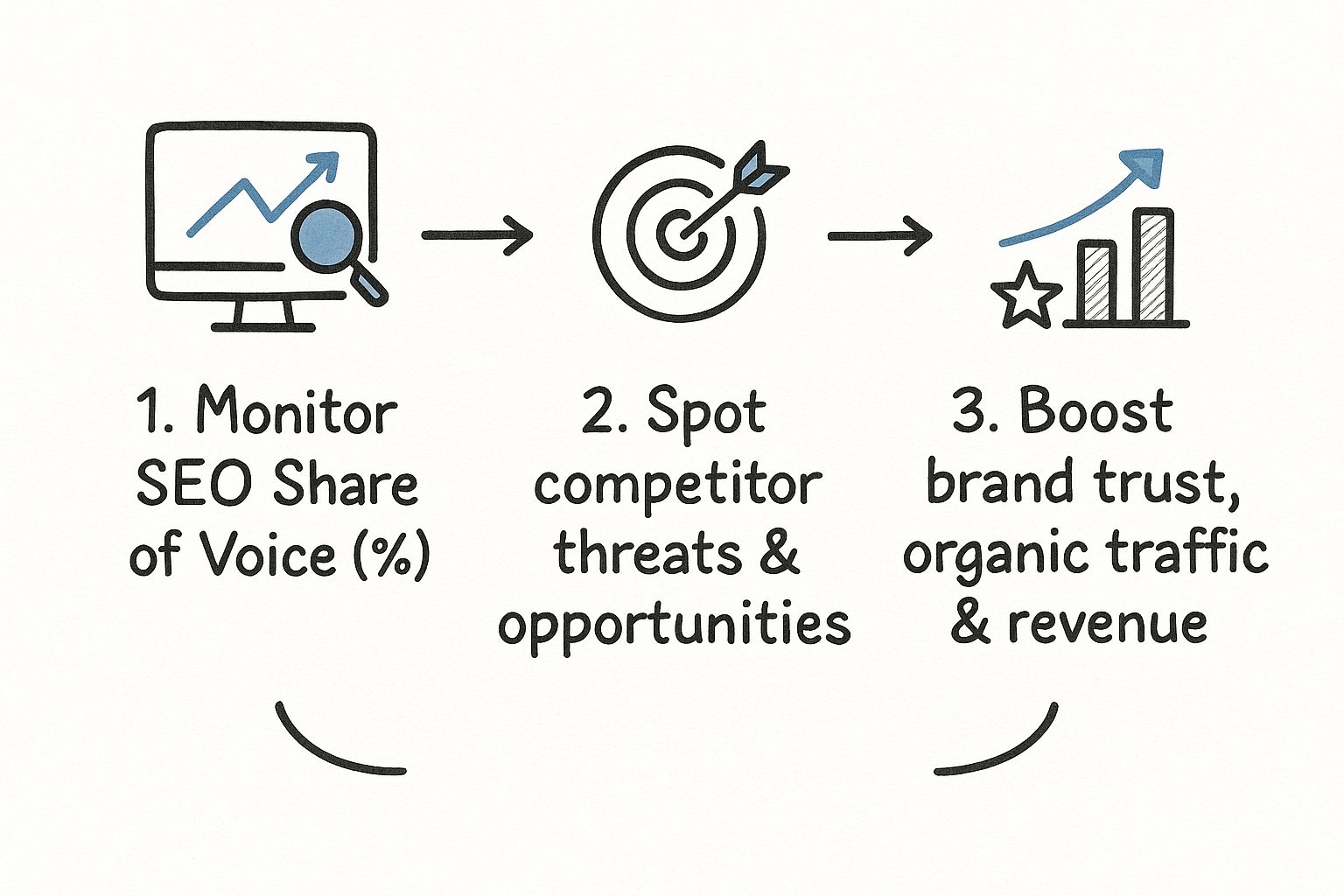Boost Your Share of Voice SEO Today | Proven Strategies

Maxime Dupré
10/12/2025

When you're deep in the weeds of SEO, it's easy to get fixated on individual keyword rankings. But what if there was a metric that gave you a bird's-eye view of your entire competitive landscape? That metric is Share of Voice (SOV).
Think of it as your brand’s overall visibility in the organic search results for the keywords that matter most, measured against your key competitors. It’s not just about one keyword; it’s about how much of the total conversation in your niche you actually own.
What Is Share of Voice in an SEO Context
Let's use an analogy. Imagine your industry is a massive, bustling farmer's market, and every potential customer is looking for the best produce (your products or services). Share of Voice is how many stalls you have and how visible they are compared to everyone else. It’s a measure of your market presence, not just in one aisle, but across the entire market.
This idea shifts the focus away from just tracking where you land for one or two "money" keywords. Sure, ranking #3 for a major term is a win, but share of voice SEO answers a much more strategic question: Of all the searches happening for what we do, what percentage of that traffic are we capturing?
Moving Beyond Simple Rank Tracking
A high rank for a single, high-volume keyword is fantastic, but it's only one piece of the puzzle. What about the hundreds of long-tail keywords your competitors might be quietly dominating? This is exactly why measuring SOV is so crucial. It rolls up multiple data points to give you a real, actionable benchmark of your position in the market.
Share of Voice provides a clear picture of your competitive landscape and market authority. It’s less about winning a single race and more about your overall performance across the entire marathon.
When you start calculating your SOV, you uncover insights that standard SEO reports often completely miss. For instance, you can:
- Spot Emerging Competitors: Catch those up-and-comers who are starting to chip away at your visibility on keywords you aren't watching as closely.
- Identify Content Gaps: See entire topic areas where your competitors are the go-to resource, and you're nowhere to be found.
- Find Strategic Opportunities: Pinpoint a market leader's weak spots, giving you a clear opening to attack.
Ultimately, tracking your share of voice SEO gives you a serious strategic edge. You move from a reactive mode—scrambling when a ranking drops—to a proactive one. You can anticipate threats, seize opportunities, and steer your content and link-building strategies with much greater confidence. It turns SEO from a simple checklist into a powerful engine for market leadership.
Why Measuring SEO Share of Voice Is a Game Changer
Focusing only on individual keyword rankings is like watching a single player on a football field. Sure, you know what that one person is doing, but you're missing the entire game. Measuring your SEO share of voice, on the other hand, gives you that full-field view. It’s a strategic metric that shows you not just how you're performing, but how you truly stack up against everyone else out there.
When your brand consistently pops up in search results for the right queries, it builds a powerful sense of familiarity and authority. That visibility quickly translates into brand trust, which is a massive driver for organic traffic and, ultimately, revenue. Think of SOV as an early warning system for your brand's overall health in the market.
Spotting Threats and Seizing Opportunities
Keeping a close eye on your share of voice helps you catch subtle shifts in the competitive landscape before they turn into major headaches. You might, for example, notice a new competitor quietly gaining ground on a whole cluster of your long-tail keywords. That insight is your cue to act, letting you reinforce your content or ramp up link-building before they can swipe a meaningful chunk of your traffic.
By making SEO Share of Voice a core part of your dashboard, you transform your strategy from reactive to predictive. You’re no longer just defending rankings; you're actively seeking market dominance by understanding the entire competitive ecosystem.
This kind of continuous monitoring is a cornerstone of smart market analysis. You can dig deeper into staying ahead by understanding what is competitive intelligence and weaving its principles into your SEO work. This proactive stance helps you put your resources where they’ll count the most, focusing on the moves that will actually grow your brand.
The visual below breaks down how tracking SEO share of voice creates a clear path to spotting opportunities and driving real business results.

It really is that simple: consistent monitoring informs strategic action, and that action delivers tangible outcomes like more traffic and higher revenue.
The Undeniable Power of Organic Search
You really can't overstate how important it is to own this visibility, especially in organic search. Google is handling over 8.5 billion searches every single day, and organic results pull in a staggering 94% of all clicks.
And it gets even more competitive. With about 75% of users never bothering to scroll past the first page, landing those top spots isn't just nice—it's essential for a strong share of voice. This is why a high SOV is far from a vanity metric; it’s a direct indicator of your ability to capture a piece of this massive pie.
How to Calculate Your SEO Share of Voice

Alright, let's get down to the brass tacks. Turning a concept like "visibility" into a solid number you can actually use might seem daunting, but it's more straightforward than you think. Calculating your share of voice SEO is all about a clear, repeatable process that gives you a real snapshot of where you stand in the market.
The goal is simple: figure out what percentage of the total available organic traffic for your most important keywords is landing on your website.
The Basic Formula for SOV
At its heart, the math is refreshingly simple. You're just comparing your piece of the pie to the whole pie.
SOV % = (Your Brand's Estimated Clicks / Total Market's Estimated Clicks) x 100
This little formula is your new best friend. It gives you a powerful benchmark to track over time. Let's say your site pulls in 40,000 clicks from your target keyword list, and the total market for those same keywords is about 200,000 clicks. Your share of voice SEO is a solid 20%. Just like that, you know exactly how much of the conversation you currently own. As Shopify's guide on the topic points out, this metric is invaluable for strategic planning.
But where do you get those "estimated clicks" numbers? That's where we need a good process.
A Step-by-Step Calculation Guide
You don’t need a degree in data science to figure this out. By breaking it down, you can get a clear, actionable metric without getting lost in the weeds.
Define Your Keyword Battlefield: First things first, you need to know which keywords you're fighting for. This isn't just about your top five vanity terms. You need a comprehensive list of the high-intent keywords that define your products and services—the exact phrases your customers are typing into Google.
Gather the Data: For every keyword on your list, you'll need two things: its monthly search volume and the estimated click-through rate (CTR) for each position on the search results page. Tools like Ahrefs or Semrush are perfect for pulling search volumes, and you can find well-established CTR benchmark studies to estimate clicks based on ranking.
Calculate Your Visibility Score: Now, for each keyword you rank for, multiply its search volume by the CTR for your ranking position. For example, if a keyword gets 10,000 searches a month and you're sitting at #2 (which has an estimated CTR of, say, 15%), your estimated traffic for that one keyword is 1,500 clicks. Do this for all your ranking keywords.
Do the Same for Competitors: This is the legwork. You need to repeat the exact same process for each of your main competitors across that entire keyword list. It’s tedious, but this is the only way to accurately size up the entire market.
Put It All Together: Add up all the estimated clicks for your brand to get your total. Then, do the same for your competitors and add their totals to yours to get the total market clicks. Plug those two numbers into the SOV formula we covered, and you've got your share of voice percentage.
To make this even clearer, let's walk through a simplified example. Imagine you and two competitors are targeting a small set of keywords.
Manual Share of Voice Calculation Example
| Data Point | Your Brand | Competitor A | Competitor B | Total Market |
|---|---|---|---|---|
| Keyword 1 Search Volume | 5,000 | 5,000 | 5,000 | 5,000 |
| Keyword 1 Rank (CTR %) | #3 (11%) | #1 (28%) | #5 (7%) | - |
| Keyword 1 Clicks | 550 | 1,400 | 350 | 2,300 |
| Keyword 2 Search Volume | 10,000 | 10,000 | 10,000 | 10,000 |
| Keyword 2 Rank (CTR %) | #1 (28%) | #4 (9%) | #2 (15%) | - |
| Keyword 2 Clicks | 2,800 | 900 | 1,500 | 5,200 |
| Total Estimated Clicks | 3,350 | 2,300 | 1,850 | 7,500 |
Based on the table, your brand's total estimated clicks are 3,350, and the total market clicks are 7,500.
Using the formula: (3,350 / 7,500) x 100 = 44.6% SOV.
This shows that even with a simplified list, you can quickly get a quantifiable measure of your market dominance.
The Best Tools for Tracking Share of Voice
Manually calculating your share of voice SEO is a great way to get a feel for how it works, but let's be honest—it’s a massive time sink. Can you imagine trying to update all that data every single week? It’s completely impractical. Thankfully, some powerful tools can automate the entire process, giving you a live look at the competitive battlefield without all the manual grunt work.
These platforms do the heavy lifting: tracking keywords, estimating traffic, and keeping a close eye on your competitors. Automating this frees you up to focus on what actually matters—analyzing the data and making smart moves to grow your market share. The right software turns share of voice from a static, one-time report into a living, breathing metric that guides your daily strategy.
Essential Platforms for SOV Measurement
Choosing the right tool usually comes down to your specific needs and budget. A few industry-leading platforms have robust features built just for measuring your share of voice.
Here are some of the top contenders:
- Semrush: A titan in competitive intelligence, Semrush’s "Market Explorer" and position tracking reports give you a "Visibility %" score, which is essentially their take on SOV. It's fantastic for getting a bird's-eye view of your entire market.
- Ahrefs: While legendary for its backlink data, Ahrefs' "Rank Tracker" is a beast for measuring SOV. You can tag keywords, add your rivals, and watch your overall visibility percentage change over time, showing you exactly how you stack up.
- Moz Pro: Moz offers a "Search Visibility" score that represents your share of the clicks for the keywords you’re tracking. Its campaign-based approach makes it simple to monitor your SOV progress against your direct competitors.
These tools are all part of a bigger picture called search engine marketing intelligence, which is all about using data to make smarter decisions.
Turning Data Into Actionable Strategy
Just having the numbers isn't enough. The real magic happens when you turn those metrics into an actual plan. When a tool shows your SOV has dipped, you can dive in to see exactly which competitor is gaining ground and on which specific keywords. This lets you make a precise, targeted response instead of just guessing.
A good SOV tool doesn't just give you a score. It tells you a story about the market, highlighting where your competitors are winning and where your next big opportunity lies.
To stay on top of the game, using the best AI rank tracker tools is becoming critical for measuring your Share of Voice accurately. These newer platforms often provide more precise click-through-rate data and even predictive analytics.
By setting up automated reports and alerts, you’ll get a heads-up about any major shifts in the search results. This allows you to react quickly, whether you're fending off a threat or jumping on a new opening. Suddenly, your share of voice SEO isn't just a look in the rearview mirror—it's a forward-looking strategic advantage.
Proven Strategies to Increase Your SEO Share of Voice

Knowing your share of voice score is the starting line, not the finish. Now the real work begins: actively growing that number and carving out your brand’s authority in the search results. Increasing your share of voice SEO isn't about just doing more of the same; it's about making smarter, more strategic moves.
Think of it like claiming territory on a digital map. You need a solid plan to expand your influence, targeting not just the major highways but all the valuable side streets where your customers are searching for answers. The goal is to find your competitors' blind spots and build a presence they simply can't ignore.
Find and Exploit Keyword Gaps
The quickest way to gain ground is to figure out where your competitors are winning and you aren’t even on the field. This is where a keyword gap analysis comes in—it’s the perfect reconnaissance mission. It shows you all the keywords your rivals are ranking for that you’ve missed completely.
This process shines a light on untapped opportunities to pull in high-intent traffic. Instead of fighting a brutal, head-on battle for hyper-competitive terms, you can strategically capture valuable long-tail keywords your competition has overlooked. These less competitive phrases often attract more qualified visitors and are easier to rank for, giving you quick wins that boost your overall SOV.
Once you’ve identified these gaps, you can create content that specifically answers those user queries, effectively stealing visibility right from under your competitors' noses.
Establish Authority with Topic Clusters
Google loves expertise. To prove you're an authority in your space, you can’t just publish a bunch of random blog posts. The winning strategy here is building comprehensive topic clusters—a collection of interconnected, in-depth articles all centered around one core "pillar" topic.
The model is simple: you create a main pillar page that covers a broad subject, and then you link it to several "cluster" pages that dive deep into specific subtopics. This structure sends a powerful signal to search engines that you have a deep, commanding understanding of your niche.
A well-executed topic cluster strategy does more than just organize your content; it builds a fortress of expertise around your most important subjects, making it incredibly difficult for competitors to challenge your authority on that topic.
This approach doesn't just improve your rankings for a wide range of related keywords. It dramatically grows your share of voice SEO by demonstrating true topical dominance. You’re telling Google that when it comes to your subject, your website is the definitive resource.
Dominate with Backlinks and Technical SEO
Your off-page reputation and your site's technical health are absolutely critical for expanding your reach. A strong profile of high-quality backlinks acts as a series of endorsements from other reputable sites, directly boosting your authority and search rankings. Building these links is a foundational step in growing your SOV. A great tactic is to learn how to find backlinks on Google that your competitors already have and then replicate their success.
At the same time, you can't afford to neglect your website's foundation. A mobile-first design and lightning-fast loading speeds are table stakes now. With most searches happening on mobile devices, a clunky mobile experience can cripple your visibility and hand a massive advantage to your competitors. For local businesses, learning how to optimize Google Business Profile is another powerful way to own the local search results.
How Emerging Trends Are Reshaping Share of Voice
The way we measure visibility is constantly in flux, and the biggest game-changers on the horizon are AI search and voice assistants. These technologies are turning traditional search on its head, moving us away from a list of blue links and toward a more direct, conversational experience.
Think about it: when AI-powered search provides a single, summarized answer at the very top of the page, just ranking on page one doesn't cut it anymore. The new brass ring is becoming the source for that answer. This means fighting for what we call Position Zero—that coveted featured snippet—or being the go-to citation in an AI-generated response.
This shift is accelerating, largely thanks to the explosion of voice search.
The Impact of Voice Search on SOV
Voice search isn't just a different way to ask a question; it's a completely different battlefield. When someone asks their smart speaker or phone a question, they aren't typing in two or three words. They're asking full, conversational questions, and they expect a single, direct answer.
Voice search commands a different kind of real estate. Capturing this market requires more than just ranking; it demands providing the single best, most concise answer to a user's question.
The data paints a clear picture. The average voice query is around 29 words long, a stark contrast to the short, punchy phrases we type. And where do the answers come from? A whopping 80% of voice answers are pulled from the top three organic results, with a massive 40.7% coming directly from featured snippets.
If you're serious about capturing your share of voice, dominating those top spots is no longer a "nice-to-have"—it's a must. You can dive deeper into these numbers by exploring more voice search statistics.
So, what's the move? Your content needs to sound more human, anticipating the natural language people use when they speak. Using structured data to give search engines crystal-clear context is crucial, as is designing your content to provide quick, authoritative answers. This isn't just about tweaking your SEO; it's about future-proofing your entire strategy to stay relevant.
Got Questions About Share of Voice? We've Got Answers.
Even after you've got the basics down, a few practical questions always seem to come up when you start applying share of voice SEO to your own strategy. Let's tackle some of the most common ones so you can move forward with confidence.
How Often Should I Be Checking My Share of Voice?
For most brands, tracking your SOV on a monthly basis is the sweet spot. It's frequent enough to catch important trends and see what your competitors are up to, but not so often that you're reacting to every minor daily blip, which can be more noise than signal.
That said, if you're in the middle of a huge product launch or a rival just kicked off a massive marketing campaign, you might want to switch to weekly tracking for a bit. This gives you faster feedback when things are changing quickly.
Isn't This Just Organic Visibility?
Not quite, though they're definitely related. Think of it this way: organic visibility is your raw score. It tells you how often you show up in the search results, period.
Share of voice is different because it adds the missing piece: context. It measures your visibility in relation to your competitors. It shows you how big your slice of the pie is compared to everyone else fighting for the same audience. A site could have great visibility for a handful of obscure terms but still have a tiny overall SOV in a crowded market.
Is It Possible to Have a High SOV but Low Traffic?
Absolutely, and it’s a great question. This happens when a site completely dominates a small group of very niche, low-volume keywords. For that specific set of keywords, their SOV could be sky-high—maybe even close to 100%—but the traffic coming from those terms would be a trickle.
This really underscores why choosing the right keyword "battlefield" is so crucial for your share of voice SEO calculations. If the metric is going to be useful, you have to make sure the keywords you're tracking actually represent a meaningful amount of search traffic in your industry.
Stop guessing what your competitors are doing. ChampSignal delivers high-signal alerts on competitor SEO changes, ad campaigns, and website updates so you can react faster and smarter. Start your free 30-day trial today.
Get Started
Competitor Monitoring That Doesn't Suck
Spend under two minutes per week monitoring your competitors. Receive only the information that matters.
Join other SMBs on top of their competitors.

